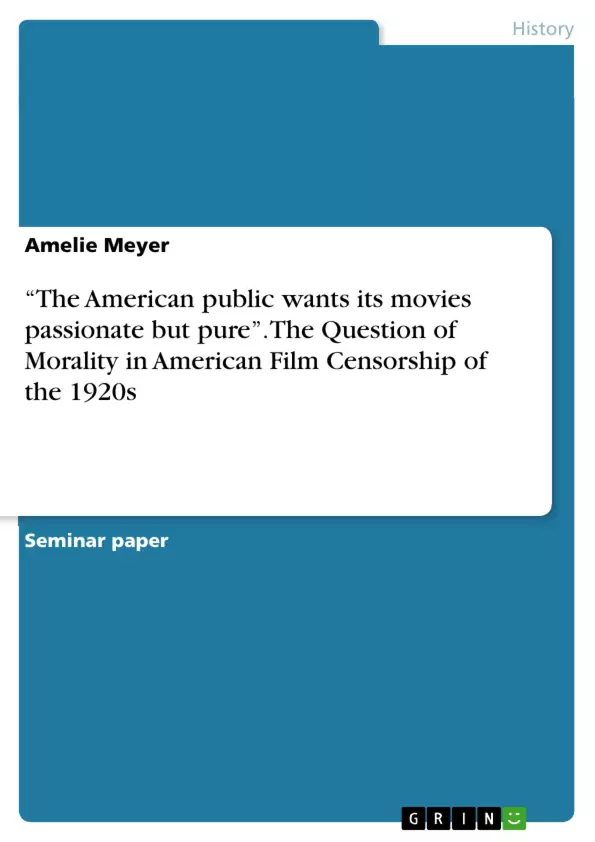For as long as there have been moving pictures, there have also been attempts to regulate their content. The first court case surrounding moving pictures has been recorded as early as 1897 and many more were to follow. While film was thus always subjected to scrutiny from various groups, the 1920s saw a more fervent battle for control over censorship which resulted in the formation of the 1930 Production Code remaining in effect until 1968.
Lee Grieveson’s study Policing Cinema: Movies and Censorship in Early-Twentieth-Century America comprehensively describes long-lasting battles over movie content regulation and the discussion of the function of cinema. Yet, he is among many scholars who sees the 1915 Supreme Court decision in the case “Mutual Film Corporation v. Industrial Commission of Ohio” as the culmination of these struggles as it proved “the validity of state censorship.” Justice McKenna is quoted ruling that “the exhibition of moving picture is a business, pure and simple, originated and conducted for profit, like other spectacles, not to be regarded … as part of the press of the country, or as organs of the public opinion.” This ruling was not only significant for the increased state and city censorship which followed, but it also fueled censorship demands by various parties including religious groups, social reformers, politicians, and journalists who all called for the elusive concept of morality.
The road from this first ruling which titled the film industry as a business to be regulated towards a formal censorship with the aim of restoring morality manifested in the so-called Production Code in 1934 will be the focus of this paper. The first part will consist of an analysis of the various parties involved in the attempt to regulate movie content in order to expose the individual motives behind their requests as well as their practices to reach their goal of censorship.
The following part will then deal with the question of how well the reformers were able to realize their goal of censoring the movies during the first years of the 1920s. The questions posed above will mainly be studied on the basis of guiding works written by Gregory D. Black, Francis G. Couvares, Stephen Vaughn, Lee Grieveson and Leonard J. Leff. Analyzed sources will include newspaper articles, state review board standards, studies on audience behavior, and an original text written by a direct participant of the 1920 censorship struggle, MPPDA president William Hays.
Table of Contents
- Introduction
- Demanding Morality, Calling for Censorship
- State Censorship Boards
- Reform Groups
- The Hays Office
- Morality Restored? Impacts of early 1920 Film Censorship
- Filmmakers and Actors
- The Hays Office and the Need for a Formal Production Code
- Conclusion
Objectives and Key Themes
This work examines the development of American film censorship in the 1920s, highlighting the growing tension between artistic expression and moral concerns. The study explores the rise of film as a popular medium and its influence on American culture, the development of censorship mechanisms, and the impact of these regulations on filmmakers, actors, and audiences.
- The transformation of film from an art form to a mass-consumed good
- The changing demographics and behaviors of movie audiences
- The emergence of "moral panic" and the call for censorship
- The legal battle for censorship and the Supreme Court's decision in Mutual Film Corporation v. Industrial Commission of Ohio
- The impact of censorship on the creative freedom of filmmakers and actors
Chapter Summaries
The introduction lays the foundation by outlining the evolution of film censorship, tracing its history to the early 20th century. It emphasizes the rising popularity of film and its impact on American culture and society. The first chapter examines the different forces that contributed to the demand for film censorship in the 1920s, including state censorship boards, reform groups, and the Hays Office. It explores the motivations behind these efforts and their strategies for enforcing moral standards in film. The second chapter focuses on the consequences of early film censorship, analyzing its impact on filmmakers, actors, and the creative process. It examines the Hays Office's role in the development of a formal production code and the limitations imposed on film content.
Keywords
American film censorship, 1920s, morality, film industry, Hays Office, Production Code, audiences, moral panic, free speech, Supreme Court, Mutual Film Corporation v. Industrial Commission of Ohio.
- Citation du texte
- Amelie Meyer (Auteur), 2012, “The American public wants its movies passionate but pure”. The Question of Morality in American Film Censorship of the 1920s, Munich, GRIN Verlag, https://www.grin.com/document/537937



